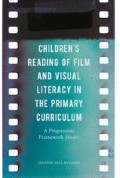Abstract
The final chapter synthesises the data explored in Chapters 4, 5, 6, and 7, in order to create a table which demonstrates the stages of the spiral progression framework. This should be an accessible model in supporting teachers to further develop the use of film in the primary curriculum. It emphasises the need for the framework to be a spiral model, as children will move around the stages, depending on the complexity of the text, and it revisits how this can be useful in supporting children to transfer their reading skills across a range of media. It explores the comparisons which can be made between the reading of print and film. It also considers the limitations of this study, the scope for future research and the implications for policy and practice.
Access this chapter
Tax calculation will be finalised at checkout
Purchases are for personal use only
References
Bazalgette, C. (2010). Teaching media in primary schools. London: Sage.
Bearne, E., & Wolstencroft, H. (2007). Visual approaches to teaching writing: Multimodal literacy 5–11. London: Paul Chapman Publishing.
Bearne, E., & Bazalgette, C. (2010). Beyond words: Developing children’s response to multimodal text. Leicester: UKLA.
Black, P., & Wiliam, D. (1998). Inside the black box: Raising standards through classroom assessment. London: King’s College School of Education.
Braun, V., & Clarke, V. (2006). Using thematic analysis in psychology. Qualitative Research in Psychology, 3(2), 77–101.
British Film Institute. (2003). Look again. London: British Film Institute.
British Film Institute. (2012). Film forever. London: BFI Publications.
Buckingham, D. (2003). Media education: Literacy, learning and contemporary culture. Cambridge: Polity Press.
Buckingham, D., & Willett, R. (2006). Digital generations—Children, young people and new media. London: Routledge.
Buckland, W. (2008). Film studies. Oxon: Hodder Headline.
Burn, A. (2007). The place of digital video in the curriculum. In R. Andrews & C. A. Haythornthwaite (Eds.), The Sage handbook of e-learning research. London: Sage.
Burn, A., & Parker, D. (2003). Analysing media texts. London: Continuum Books.
Burn, A., & Durran, J. (2007). Media literacy in schools—Practice, production and progression. London: Paul Chapman Publishing.
Clark, B. (2014). Enhancing English teaching through film, English 4–11, Number 50, Spring 2014. Leicester: UKLA.
Creswell, J. W. (1988). Qualitative inquiry and research design—Choosing among five traditions. London: SAGE Publications Ltd.
Department for Education. (2013a, July). Primary assessment and accountability under the new national curriculum. London: DfE.
Department for Education. (2013b, September). The national curriculum in England—Framework document. London: DfE.
Essex Writing Project Group. (2007). Lights, camera, action—Using a multimedia approach to switching on turned off writers. Essex: Essex County Council.
International Association for the Evaluation of Education Achievement, Mullis, V. S., Martin, M. O., Foy, P., & Drucker, K. T. (2011). Progress in international reading study, international results in reading. Boston: Lynch School of Education.
Kress, G. (2003). Literacy in the new media age. London: Routledge.
Levy, R. (2011). Young children reading at home and at school. London: Sage.
Luke, A., & Freebody, P. (1999). Further notes on the four resources model [Online]. Retrieved June 24, 2011, from http://www.readingonline.org/research/lukefreebody.html
Marsh, J. (2005). Ritual, performance and identity construction: Young children’s engagement with popular culture and media texts. In J. Marsh (Ed.), Popular culture, new media and digital technology in early childhood. Oxen: RoutledgeFalmer.
Marsh, J., & Bearne, E. (2008). Moving literacy on. Leicester: The University of Sheffield and UKLA.
Ofsted. (2014, April). English survey visits [Online]. Retrieved May 30, 2014, from http://www.ofsted.gov.uk/resources/generic-grade-descriptors-and-supplementary-subject-specific-guidance-for-inspectors-making-judgemen
Parry, B. (2013). Children, film and literacy. Basingstoke: Palgrave Macmillan.
QCA. (2008). Assessing pupil progress—Assessment guidelines for reading/assessment guidelines for writing [Online]. Retrieved August 2, 2010, from http://nationalstrategies.standards.dcsf.gov.uk/search/primary/results/nav:45919
Rabinowitz, P. J. (1987). Before reading: Narrative conventions and the politics of interpretation. Ithaca, NY: Cornell University Press.
Robinson, M., & Mackey, M. (2003). Film and television. In N. Hall, J. Larson, & J. Marsh (Eds.), Handbook of early childhood literacy. London: Sage.
Robinson, M., & Mackey, M. (2010). Film and television. In J. Larson & J. Marsh (Eds.), The Sage handbook of early childhood literacy (2nd ed.). London: Sage.
Scottish Government. (2008). Curriculum for excellence. Edinburgh: Scottish Government.
Scottish Screen. (2009). Moving image education in Scotland [Online]. Retrieved July 27, 2013, from http://www.scottishscreen.com/images/documents/moving%20image_2009.pdf
Scottish Screen. (2013). Film and the curriculum for excellence [Online]. Retrieved July 30, 2013, from http://www.scottishscreen.com/content/subpage.php?sub_id=158
Tyner, K. (1998). Literacy in a digital world: Teaching and learning in the age of information. Mahwah, NJ: Erlbaum.
UK Film Council. (2008). Film: 21st century literacy [Online]. Retrieved June 26, 2011, from http://www.21stcenturyliteracy.org.uk/
Author information
Authors and Affiliations
Rights and permissions
Copyright information
© 2017 The Author(s)
About this chapter
Cite this chapter
Bulman, J.H. (2017). Conclusion: The Spiral Progression Framework. In: Children's Reading of Film and Visual Literacy in the Primary Curriculum. Palgrave Macmillan, Cham. https://doi.org/10.1007/978-3-319-58313-6_9
Download citation
DOI: https://doi.org/10.1007/978-3-319-58313-6_9
Published:
Publisher Name: Palgrave Macmillan, Cham
Print ISBN: 978-3-319-58312-9
Online ISBN: 978-3-319-58313-6
eBook Packages: EducationEducation (R0)

